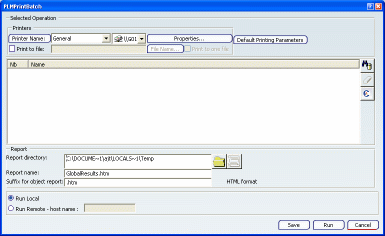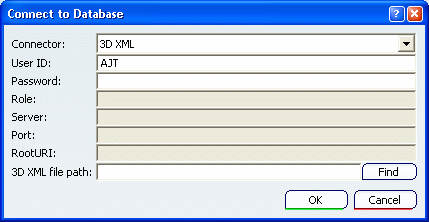Before you start, note that the printing parameters you define apply
globally to all the objects to be printed, you cannot modify these
parameters for each object individually.
Select a printer using the list displayed next to
Printer Name.
Click Properties... to set up the printing parameters.
Optional: To print to a
file, select the Print to file check box
then
enter a file name or click File Name....
Depending on the location of the objects to be converted, click:
Optional: If you are searching for objects stored in a database other than ENOVIA V6, click  or if you are searching for file objects, click
or if you are searching for file objects, click  to access the dedicated search interface.
to access the dedicated search interface.
For more information about how to search for file objects, see Infrastructure User's Guide: Infrastructure Tools: Running Batches: Running the DownwardCompatibility Batch: Searching for Files.
The objects to be converted are listed in the batch window.
Click
Default Printing Parameters to define the parameters used by
default for all printed documents:

In the Printing Parameters
dialog box, use the Layout tab to define the page
orientation, the image size and position.
Use the
Visualization tab to define the visualization mode to be
used for printing.
Optional: If you are printing CATDrawings, access the
MultiDocuments tab
to define sheet options.
Click Save then
browse your file tree to save your XML file in the desired location.
Click Run.
The selected documents are printed.
In the Batch Monitor, access the Start tab.
The name and location of the XML file
containing the batch parameters you defined in the previous steps (as
well as the name of the host computer if you run the batch in remote
mode) are now displayed:

Access the
Processes
tab then double-click the desired batch in the list.
Information on the batch execution is displayed. See Infrastructure User's Guide: Infrastructure Tools: Running Batches: Running Batches Using the Batch Monitor for more information about this tab.
Optional: Click
Open HTML Report
 .
.
An HTML version of the report is displayed.
This button is activated only when a report has been
generated.You can still visualize the report by opening the HTML file from the directory in
which it has been saved.
Click Close to close the window then
Cancel to close the PLMPrintBatch.
Select to
exit the Batch Monitor.
To read the reports generated by the batch execution, access the folder c:\temp\batchID.
See Infrastructure User's Guide: Infrastructure Tools: Running Batches: Running Batches Using the Batch Monitor for more information about this tab.
![]()
![]()

 to search for objects stored in other connectors (e.g. VPMV5, 3D XML, etc.) :
to search for objects stored in other connectors (e.g. VPMV5, 3D XML, etc.) :




